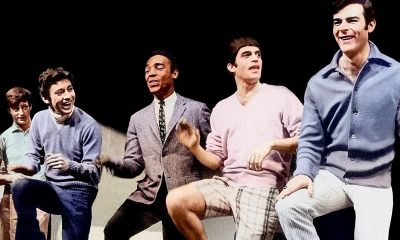Theater
Rarely performed Tennessee Williams work cleverly staged by Rainbow Theatre Project
Characters are dead in non-linear, initially panned 1980 character study
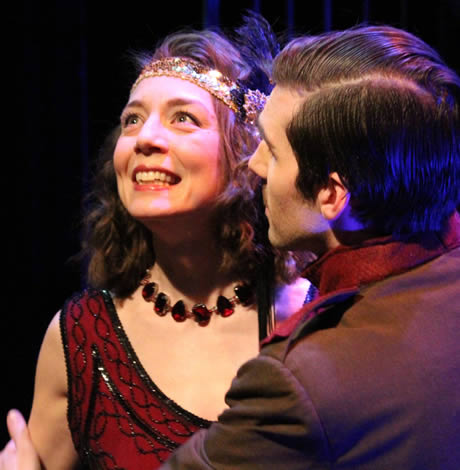
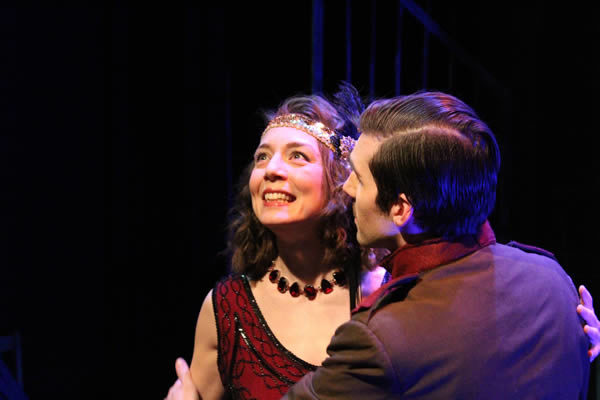
‘Clothes for a Summer Hotel’
Through April 28
Rainbow Theatre Project
DC Arts Center
2438 18th St., N.W.
$35
“Clothes for a Summer Hotel” may never be your favorite Tennessee Williams’ play, but it’s definitely worth seeing. And now’s your chance with Rainbow Theatre Project’s engaging take on the legendary out playwright’s seldomly staged, poignant late work.
By peeking into the failed relationship of famed novelist F. Scott Fitzgerald and wife Zelda, Williams’ also explores his own struggles. He employs metaphor, lyricism, his trademark wit and returns to subjects close to his heart: madness and tragic women. Tales of the Fitzgerald’s high times — jumping into fountains, dancing and popping Champagne corks — aren’t the focus here.
From the top, Williams tells us it’s a “ghost play,” all of it characters are dead and time and place are fluid. So, unlike “A Streetcar Named Desire” and his memory play “The Glass Menagerie,” chronology isn’t straightforward. The characters know their pasts, presents and their future fates. This lack of linear narrative is one of the reasons the play was almost uniformly panned by reviewers when it premiered on Broadway in 1980. But don’t let that deter you.
The action takes place over a one-day visit at Highland, a windy hilltop asylum near Asheville, N.C., where Zelda Fitzgerald (Sara Barker) spent time and ultimately died in a fire in 1948. When we meet her, she’s futilely pursuing ballet and undergoing insulin shock therapy.
After a long absence, Scott (Aiden Hughes) has flown in from Hollywood where he scribbles screenplays without much success. He’s in ill health and his star has dimmed (it will regain its literary luster in a decade or so); still he’s eager to see his wife whom he’s been told is a dramatically improved. Instead, he finds a disheveled woman dressed in a sad tutu, angry and unhappy.
Looking equally out of place in his summer suit and white bucks (he packed in haste), Scott is peeved. He’s uncomfortable with the familiarity shown his wife by some of the Highland staff, particularly a soothingly creepy intern (Brian J. Shaw). Soon, it’s revealed that the couple’s storied marriage is over amidst an almost ponderous exchange of recriminations.
Clearly, Williams finds in Zelda yet another wronged, faded belle. She’s vulnerable, tough and borderline hysterical. As Zelda, Barker gives glimpses of the beauty and wit that made her the Jazz era’s favorite party girl, and the pathos and frustration brought on by mental illness. Barker’s is a nuanced performance.
Out director Greg Stevens has lovingly made some additions including The Writer, a stand-in for Williams played by actor Matty Griffiths, who is creating the play as it unfolds. Perched upstage sipping gin, pecking at his
The second act take a break from the sanatorium, and gives the able cast further opportunities to shine. It’s the 1920s, Scott and Zelda are killing time on the French Riviera where Zelda (turned out in in a chic gown compliments of designer Maria V. Blissex) is consummating a flirtation with Edouard (also Shaw), a dashing French aviator, while a briefly sober Scott holes up alone, trying to write.
Next, it’s a swank party at a nearby villa belonging to famed American golden couple of convenience, Gerald Murphy (Seth Rosenke who also plays Zelda’s psychiatrist) and Sara (May). On hand are Scott’s contemporary Ernest Hemingway (wonderfully underplayed by Griffiths) and wife Hadley (Gallalee). Barbara Papendorp is a hoot as partygoer Mrs. Patrick Campbell, a grand dame and former actress who deflects insults and levels witticisms with equal aplomb.
But among the revelers, Zelda and Scott are singularly miserable: She because Edouard has left her and he because his literary idol Joseph Conrad has died and no one seems to care. Certainly, Sara is more concerned with a drunken Scott possibly breaking her baccarat crystal.
In a subtly rendered and well-acted scene, Hemingway and Scott slip away to discuss their uncomfortable friendship. They reminisce about a trip to Lyon when a vulnerable and still pretty Scott became ill and Hemingway nursed him through the night. What else might have happened that night is pure conjecture. But Williams fans the flame of rumor.
Throughout “Clothes for a Summer Hotel,” Zelda is haunted by a fiery red-colored bush on the asylum grounds. At one point, she recalls how she was never afraid of death, but that was before she knew how she would die. Pure Williams. Poetic and unsettling.
Theater
Reggie White explores the many definitions of home in ‘Fremont Ave.’
‘Music and humor set against the rhythm of a cutthroat game of spades’
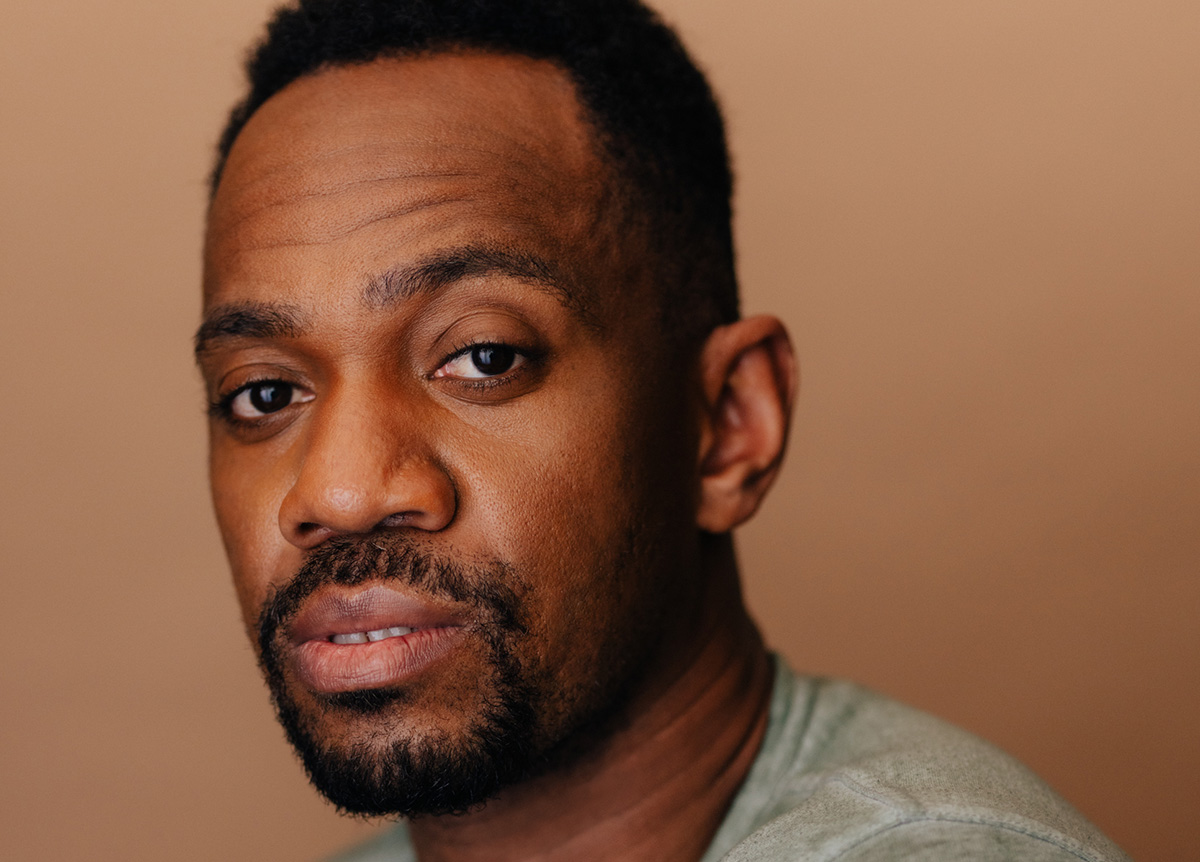
‘Fremont Ave.’
Through Nov. 23
Arena Stage
1101 Sixth St., S.W.
Tickets start at $49
Arenastage.org
For Reggie D. White, growing up Black and queer in the late 1980s and early ‘90s, there wasn’t a lot of vocabulary for his experience outside of the AIDS crisis. Despite being surrounded by family who loved him, White felt isolated in his own home; there was a sort of membrane that prevented him from being present.
With his new play “Fremont Ave.,” now running at Arena Stage, White has written a work about home and the many definitions of that idea specifically relating to three generations of Black men.
Set in a house on a street in a Southern California suburb (similar to where White grew up), “Fremont Ave.” explores the ways a lack of belonging can be passed down generationally. The first act is boy meets girl and creating a home; and the second watches the next generation struggling to achieve something different.
“The third act’s storyline is deeply queer,” White explains. “Boyfriends Joseph and Damon have been together for years yet can’t figure out what it means to make a home. We don’t totally see the relationship solved, but there’s a glimmer of hope that it just might make it.”
The playwright notes, it’s not all about familial angst and alienation: “Much of the play is music and humor set against the rhythm of a cutthroat game of spades.”
Playwright, actor, and educator, White “does all the things.” Currently, he holds the title of Arena’s senior director of artistic strategy & impact, a role focused on artistic vision and growth. Superbly energetic, White splits his time between Arena and his prized rent-stabilized residence in Brooklyn’s desirable Park Slope neighborhood. He’s already told his landlord that he’s never leaving.
At seven, he came close to landing the part of young Simba in the pre-Broadway “Lion King.” Soured by the near miss, White turned his attention to sports and studies. In his freshman year at college in the Bay Area, he took a musical theater class for the heck of it, and soon gave up law school ambitions to focus on show biz. He went on to appear in Matthew López’s Broadway success “The Inheritance” until the pandemic hit.
Winning the Colman Domingo Award in 2021 gave White the flexibility to write “Fremont Ave.” (The award is given to a Black male or male-identifying theater artist and includes a cash stipend and development opportunities.)
“It can be scary to make a career in the arts. I ran from it for a long time. Then one morning I just woke up very grateful for the accumulation of accidental circumstances that landed me in this moment.”
WASHINGTON BLADE: Is queerness your secret to success?
REGGIE D. WHITE: I’m not saying that being queer is my mutant super power, but I do think there is an element of living my life on the margins trying to find a place for myself that I’ve been able to observe relationships and how people engage and interact with each other that gives me a real objective eye on how to render a world that I didn’t live in.
BLADE: What’s queer about your work?
WHITE: There’s this thing that James Baldwin said a lot, it’s about being on the outside of an experience, being able to observe more astutely. With “Fremont Ave.” it felt important to me that the actor leading us through is played by a queer actor. I wanted that authenticity and that experience of having felt isolation.
It’s unique that the central man in each story, the grandfather, stepson, and grandson are played by the same queer actor Bradley Gibson, that amazing TV star with the big muscles.
It’s also interesting to watch a single body traverse over generations in the same house (altered over time by appliance and art updates).
BLADE: Premiering your play as part of Arena’s 75th anniversary season must be a thrill.
WHITE: Sometimes I ask myself, how is this happening? And I didn’t even have to sleep with anybody. But seriously, I’m lucky. Arena excels at taking great care of world premieres, and the production’s director Lili-Anne Brown has a visceral sense of how to create community and life on stage.
BLADE: What else is unique about “Fremont Ave.”?
WHITE: Men aren’t a particularly emotionally literate species, so there haven’t been a lot of plays exploring the emotional condition of men and what it means to learn to love.
For men, love looks like silence. I wanted to explore what it looks like when there’s a deep curiosity about the people we’ve known and loved.
BLADE: Was risk involved?
WHITE: I wrote a deeply personal play. That’s scary. So, to see everyone involved invest their own love into what’s my play, that’s incredible, and a great confirmation of “specificity is the key to universality.” People seeing themselves in the characters has been both beautiful and surprising.
Theater
Set designer August Henney puts new spin on Mary Shelley’s life
‘So Late Into the Night’ an ideal fall show at Rorschach

‘So Late Into the Night’
Through Nov. 2
Rorschach Theatre
The Stacks @ Buzzard Point
101 V St., S.W.
Spooky Action Theater
Washington, D.C.
Tickets start at $74
Rorshachtheatre.com
We’ve all been to that scary party or two. But ordinarily, it’s not by choice.
But with playwright Shawn Northrip’s So Late Into the Night, the spookiness is planned, executed, and fun. Northrip lays out the story of novelist Mary Wollstonecraft Shelley, famed author of the gothic masterpiece Frankenstein, and in gathering her Romantic poet friends and lovers, investigates their afterlife.
What’s more, the new play, which also features a rock séance, is performed in the Stacks at D.C.’s Buzzard Point neighborhood, a unique neighborhood positioned where the Potomac and Anacostia Rivers meet, just south of Audi Field.
At the Stacks, Rorschach is activating a high-ceilinged corner retail that serves as the company’s fall home base. Inside the cavernous space, the production’s set designer August Henney is putting a new spin on Newstead Abbey, the grand home of Lord Byron, a friend of Shelley. Included in the new look are a Victorian dining table (33 by 12 feet), grand drapes, and modern rock and roll posters. Audience members can sit at the table or the risers on the perimeter.
Henney, who identifies as a trans gay man, is a Bay Area transplant who arrived in D.C. three years ago to study scenic design at the University of Maryland. The experience has been transformational.
WASHINGTON BLADE: How do you pursue concept before realizing a set?
AUGUST HENNEY: At first, I go through the script and take out words that spark inspiration. I’m very much a words person – I find words and then relatable images. Next, I create a collage and present it to the director.
BLADE: Along the way, does the director exert control?
HENNEY: Oh yes. It’s hopefully conversation, but they have the final say about everything. If it’s very important to me or I think it’s very important to the show, I’ll fight for it.
BLADE: When the show kicks off does your vision typically come to fruition.
HENNEY: That depends entirely on the technical director. I do the drafting and present it to the tech director. Lays out how to do that. Like an engineer and architect. This is how I want the façade to look but I don’t care so much about the insides. Comes down to what we can and can’t do. Usually comes down to cost.
BLADE: How much was learned in life and now much at school?
HENNEY: At school, I came in not knowing much. UMD cleverly matched us up with a cohort who has different skills from you. They do that well. So, there were endless hours in the hallways of the grad school where we’d build models until 3 a.m. working and blasting music. I also learned from my father who is adept at wood working, and jobs in prop shops.
BLADE: How was your coming out as a trans gay man?
Henney: Well grad school really helped with that. I believe the universe puts people in places. And with UMD, it put me in the right place. At undergrad, I got another degree in human physiology and thought I wanted to be a doctor for a second. My path would have been very different.
Scenic design placed me in range of the right people who helped me realize things about myself that I didn’t have to keep hiding. Theater is such an inclusive community already and I feel safe here while the world is so unsafe.
BLADE: This morning, I heard the administration was blaming the government shutdown on trans people. Does that kind of madness get you angry?
HENNEY: Angry, frustrated, and despondent. I get through the days by focusing on the good bits, and the people who make me feel like myself. That’s all you can really hope for in a world that’s falling apart.
BLADE: Yet, the show goes on.
HENNEY: Oh yes, and So Late Into the Night is a wonderful show. It pairs with some of the best things in the world like spooky ghost stories and dramatic rock music in autumn, the perfect season. It’s a show where audience members can feasibly be seated next to Mary Shelley and friends at a big dining table on Halloween night. How great is that?
Theater
‘The Dragon’ a powerfully subversive play once banned in Russia
Relevantly set in immigrant detention center acted out by detainees
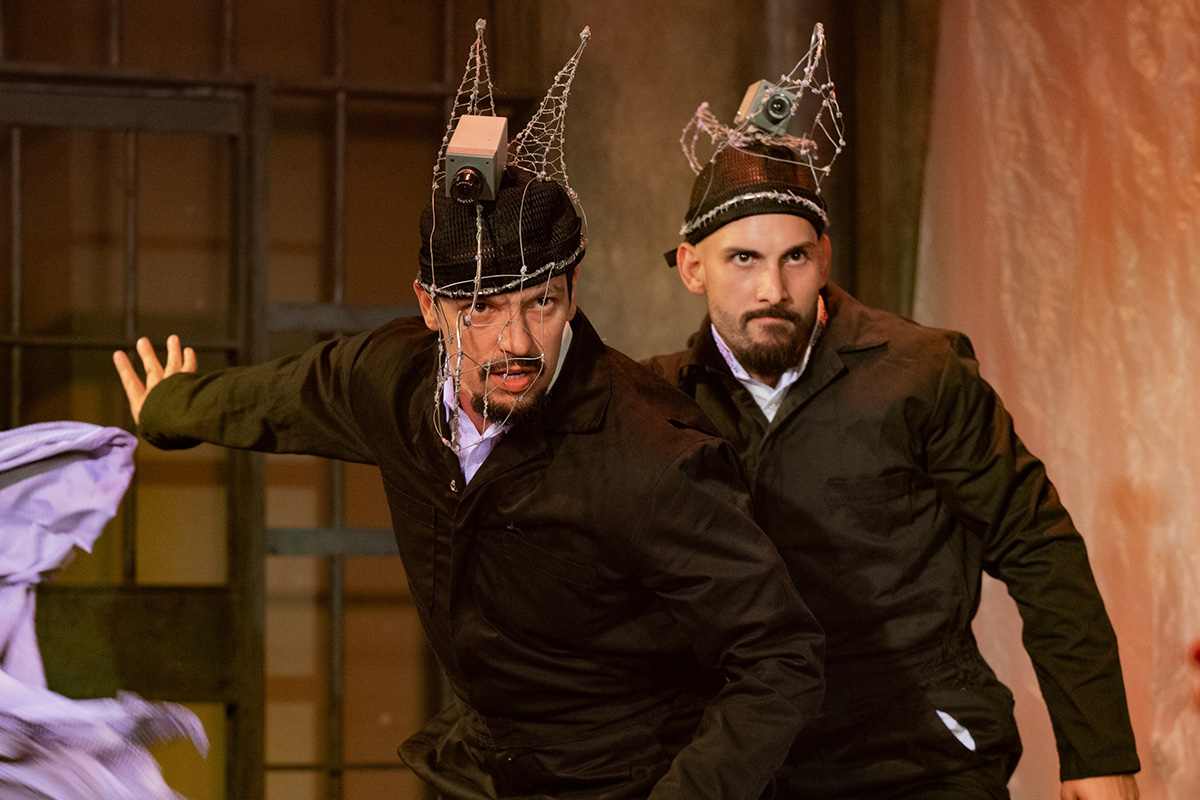
The Dragon
Spooky Action Theater
1810 16th St., NW
$23-$43
Spookyaction.org
Weird and abusive, yet still inexplicably tolerated by the populace. That describes the titular ruler in “The Dragon,” the story of how a 400-year-old authoritarian regime endures, now running at Spooky Action Theater.
Originally written by Evgeny Shvarts in the 1940s, “The Dragon” has the feel of a fairytale yet it’s a powerfully subversive play written (and banned) in Stalinist Russia.
And now adapted by Jesse Rasmussen and Yura Kordonsky for Spooky’s new production, the reworked play is relevantly and disturbingly set in an immigrant detention center with the tale acted out by the detainees. Their reality mixes with the story.
The new work is staged by the company’s artistic director Elizabeth Dinkova and performed by a five-person cast (including immigrants from South America, Syria, and Bangladesh) in Spooky’s black box theater on 16th street in the Dupont Circle neighborhood.
Included among the players are Helen Hayes Award-winning actor Fran Tapia and talented actor Gabriel Alejandro, two residents of Columbia Heights, a diverse and currently heavily policed neighborhood in Northwest. While Tapia is working with a visa for those with extraordinary ability and Alejandro is a U.S. citizen, the vibe remains extremely worrying for much of the area’s population.
Tapia, who self describes as “Chilean, Latina, queer and a proud immigrant,” says “The Dragon” resonates to her core: “Despite the stress, you keep going while everything around remains strange; you can’t be your authentic self. You’re thinking twice about what you’re saying and posting, and where and what time you go anywhere. Danger is there as much as we try to pretend it’s not.”
“The Dragon’s” actors are cast in multiple roles, Tapia plays Lancelot, the hero who comes to save the day; Sophia, a journalist who comes to report on detention center conditions; and a beautiful cat.
“As Lancelot, I’m a bit of an outsider. He’s used to fixing things and helping people in distress. In this town the people are unaware that they need help.”
And regarding real life, Tapia says, “Immigration has become topsy turvy. It’s not unusual to see people being detained in broad daylight. It’s not unusual to have five police cars parked on the corner in the afternoon. It makes us think about how people respond to authority and absurd behavior.”
Similarly, Alejandro plays multiple roles including Henry, the son of the mayor (played by Ryan Sellers) and Officer Luis, a guard in the detention center. “Luis is comparatively a nice guy,” Alejandro explains, “Yet, he accepts what’s bad about the regime he serves.”
As a Latino, Alejandro is exploring his identity through the play. “In my daily routine I’m more anxious. I present in a way that I could be a target for the government even though I’m a U.S. citizen.”
What’s happening on the streets isn’t entirely alien to what’s happening in the play, he adds. “In the play, I have some power over people who look like me. I could be in the detention center, and that’s not altogether different from what’s going on in the real world.”
Alejandro who identifies as pansexual moved from his native Puerto Rico to D.C. six years ago. After acting in just one show the pandemic hit and work dried up. Next, he attended the Shakespeare Theatre’s MFA in Classical Acting program at George Washington University, and since graduating in 2023, he’s been consistently working as an actor, something he calls “a joy and privilege.”
And as pansexual, he has an openness to people, says Alejandro. “That’s how I approach my characters. I find a way to love them. Even if they’re bad guys, I find a way to figure them out. That’s what I do here.”
“The Dragon” is satirical, and funny. Still, we know what we’re referring to in the real world, which is very scary and painful. And yet, audiences are given permission to laugh without losing the gravity of the work.
-

 District of Columbia2 days ago
District of Columbia2 days ago‘Sandwich guy’ not guilty in assault case
-

 Sports3 days ago
Sports3 days agoGay speedskater racing toward a more inclusive future in sports
-

 Celebrity News4 days ago
Celebrity News4 days agoJonathan Bailey is People’s first openly gay ‘Sexiest Man Alive’
-

 Michigan4 days ago
Michigan4 days agoFBI thwarts Halloween terror plot targeting Mich. LGBTQ bars



